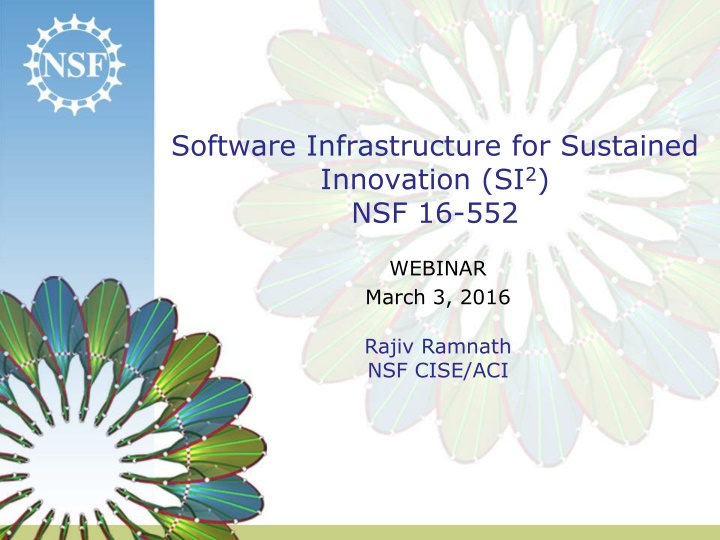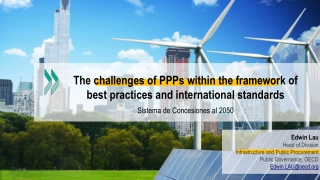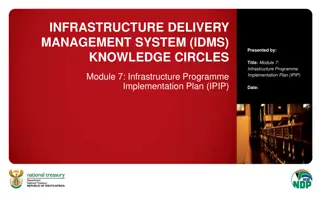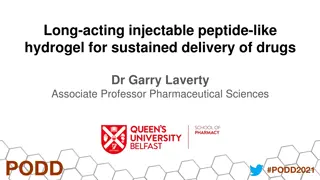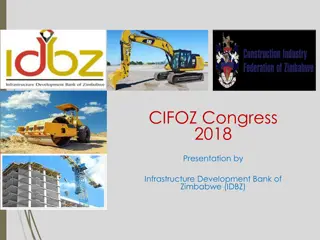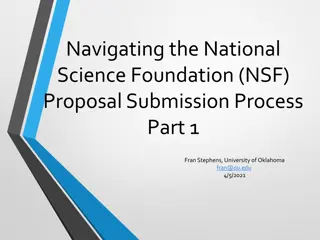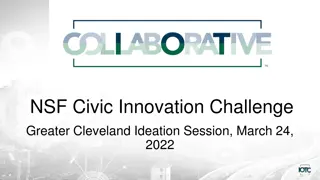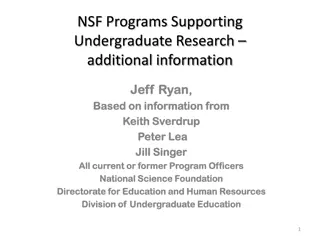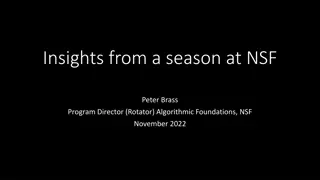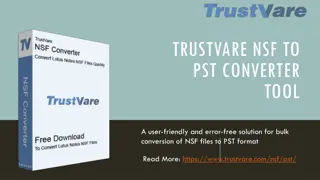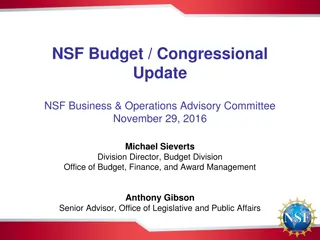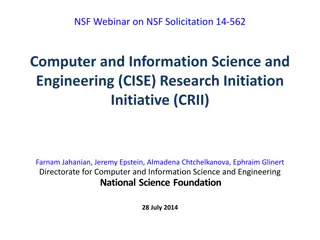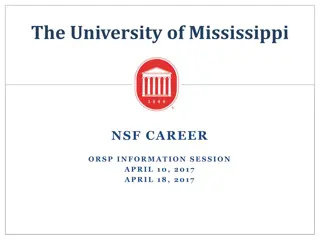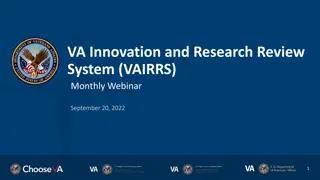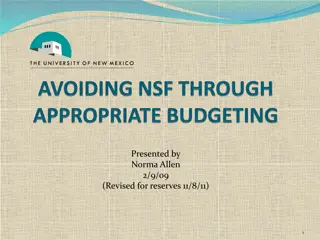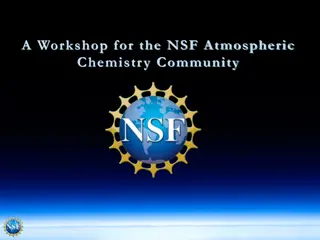Software Infrastructure for Sustained Innovation: NSF SI2 Webinar Overview
Learn about the NSF SI2 program goals and priorities, understand the solicitation requirements, and discover key information on participating NSF divisions and program officers. Enhance your proposal quality and align with the current SI2 priorities for a chance at funding.
Download Presentation

Please find below an Image/Link to download the presentation.
The content on the website is provided AS IS for your information and personal use only. It may not be sold, licensed, or shared on other websites without obtaining consent from the author.If you encounter any issues during the download, it is possible that the publisher has removed the file from their server.
You are allowed to download the files provided on this website for personal or commercial use, subject to the condition that they are used lawfully. All files are the property of their respective owners.
The content on the website is provided AS IS for your information and personal use only. It may not be sold, licensed, or shared on other websites without obtaining consent from the author.
E N D
Presentation Transcript
Software Infrastructure for Sustained Innovation (SI2) NSF 16-552 WEBINAR March 3, 2016 Rajiv Ramnath NSF CISE/ACI
Purpose of this webinar Orient potential proposers for the SI2 competition Review the program and review criterion, and answer questions Improve the quality of proposals
Participating NSF Divisions and Program Officers Directorate for Biological Sciences Division of Biological Infrastructure Peter McCartney Directorate for Social, Behavioral & Economic Sciences All divisions Cheryl Eavey Directorate for Computer & Information Science & Engineering Division of Advanced Cyberinfrastructure Rajiv Ramnath Dan Katz (till 3/25) Division of Computing and Communication Foundations Sol Greenspan Almadena Chtchelkanova Directorate for Education & Human Resources All divisions John C. Cherniavsky Directorate for Geosciences All divisions Eva Zanzerkia Directorate for Engineering Division of Civil, Mechanical and Manufacturing Innovation (CMMI) Joanne D. Culbertson, Division of Chemical, Bioengineering, Environmental, and Transport Systems (CBET) Dimitrios V. Papavassiliou Division of Electrical, Communications and Cyber Systems (ECCS) Hao Ling Directorate for Mathematical & Physical Sciences Division of Physics Bogdan Mihaila Division of Materials Research Daryl W. Hess Division of Mathematical Sciences Andrew Pollington Division of Chemistry Evelyn Goldfield Division of Astronomy Nigel Sharp
Outline SI2 goals and implementation Solicitation requirements Review criteria
NSF SI2: a multi-year initiative GOALS AND IMPLEMENTATION
Current SI2 Priorities - Towards a National Cyberinfrastructure Ecosystem Robust and reliable multidisciplinary and omni-disciplinary software That builds on other ongoing NSF-supported programs Using techniques, tools and processes for rapid integration of software that reduces cost of custom solutions and custom integrations Incorporation of software engineering processes that work for different communities Balancing innovation and research into and along with the development, effectiveness, usability, adoption, and organizational aspects of the software and the project. Serious considerations of security, trustworthiness and reproducibility. Comprehensive, innovative approaches to sustainability (e.g. SAAS, incorporation into university offerings, commercialization) Science-inspired education and LWD Comprehensive metrics (ideally of impact)
SI2 Mechanisms Create a software ecosystem that scales from individual or small groups of software innovators to large hubs of software excellence 3 interlocking levels of funding Scientific Software Elements (SSE) 1 2 PIs, <$500k, 3 years Scientific Software Integration (SSI) For focused groups $200k - $1M per year, 3 5 years
FY16 SI2 Competition: SSE & SSI 16-552 Solicitation http://www.nsf.gov/pubs/2016/nsf16532/nsf16532.htm Scientific Software Elements (SSE) SSE awards target small groups that will create and deploy robust software elementsfor which there is a demonstrated need, encapsulating innovation in science and engineering. Scientific Software Integration (SSI) SSI awards target larger groups of PIs organized around common research problems as well as common software infrastructure, and will result in a sustainable community software framework.
FY16 SI2 Competition: SSE & SSI Changes from FY14 SSE due date for first year now in April SSI due dates and start of decision process moved to September Several solicitation specific review criteria added Also note Grant Proposal Guide changes: Failure to submit by 5 p.m. submitter s local time will result in the proposal not being accepted An Authorized Organizational Representative (AOR) must provide the proposal certifications concurrently with submission of the proposal. And others. See: http://www.nsf.gov/pubs/policydocs/pappguide/nsf16001/sigcha nges.jsp
FY16 SI2 Competition: SSE & SSI Eligibility Proposals may only be submitted by: Universities and Colleges Non-profit, non-academic organizations FFRDCs may not receive funds directly from NSF under this solicitation Limit on Number of Proposals per PI or Co-PI: 1 An individual may participate as Principal Investigator, co- Principal Investigator or other Senior Personnel in at most one full proposal in the pair of SSE and SSI competitions that occurs in a given calendar year In the case of multiple proposals that include the same individual, all but the earliest will be returned without review See solicitation for details
Context for meeting SI2 goals SOLICITATION REQUIREMENTS
SI2 Proposals Should Identify the areas of science and engineering where the software is needed Compare the proposed approach to alternative or existing approaches Describe the process to design, develop, release and disseminate the software. Describe the innovation and research that have been integrated into the project activities. Describe how security, trustworthiness, reproducibility, and usability are addressed in the software Describe the impact of previously funded software efforts (if any) State which license(s) will be used expectation is a standard open source license Provide a project plan with milestones and tangible metrics Discuss the software s potential to impact science and engineering Identify a concomitant outreach and education program Propose a sustainability plan Describe how the proposed software leverages and interoperates with widely used tools by the community, and NSF and national cyberinfrastructure investments, as appropriate.
Additional Documents Data Management Plan & Postdoctoral Trainee Mentoring Plan (if project includes such trainees) Standard NSF requirement SI2 reviewers pay close attention to data management plan, since software is data, and the goal of SI2 is to produce well-used software For SSI proposals, Management and Coordination Plan: the specific roles of the PI, co-PIs, other senior personnel and paid consultants at all institutions involved how the project will be managed across institutions and disciplines identification of the specific coordination mechanisms that will enable cross-institution and/or cross-discipline scientific integration pointers to the budget line items that support these management and coordination mechanisms Letters of collaboration, if any List of Project Personnel List of all senior personnel (those with a biosketch in the proposal) List of Conflicts For each senior person, all COIs (as defined by NSF in the GPG) Submitted through FastLane/Grants.gov Also as spreadsheet via email to si2@nsf.gov
NSF standard and solicitation-specific criteria REVIEW CRITERIA
SI2 review criteria Reviewers and panel will address: Intellectual Merit, Broader Impacts, and SI2 SI2 Additional Review Criteria in their reviews, panel discussions, and panel summaries
SI2 review criteria Please note that, since 14 January 2013, the Intellectual Merit and Broader Impacts elements have new guidance When evaluating NSF proposals, reviewers will consider: what the proposers want to do why they want to do it how they plan to do it how they will know if they succeed what benefits would accrue if the project is successful These issues apply both to the technical aspects of the proposal (intellectual merit) and the way in which the project may make broader contributions (broader impacts)
SI2 SSE & SSI specific criteria - 1 To what extent does the proposed software fill a recognized need and advance research capability within a significant area (or areas) of science and engineering? To what extent does the project integrate innovation and research into the project activities? SI2 How well does the proposal present and discuss the project plan and timeline, including proof-of-concept demonstrations of key software elements and the steps necessary to take the software from prototype to dissemination into the community as reusable software resources? Does the proposal state the software license to be used and is the choice both suitably justified and appropriate, given the goals of the project? Not yes/no If the proposers claim to have previously developed widely-used software, particularly if funded under an SSE or SSI award, how significant was the use and impact of the previously funded software, as shown by the quantifiable evidence in the proposal, and is the software properly listed in the appropriate proposers' biosketches? Are tangible metrics described to measure the success of any software that may be developed? How appropriate are these metrics?
SI2 SSE & SSI specific criteria - 2 How well does the software engineering and development plan include and/or enable the integration of relevant activities to ensure the software is responsive to new computing developments? To what extent are issues of security, trustworthiness, reproducibility, and usability addressed and integrated into the proposed software? SI2 To what extent is adaptability to new technologies and changing requirements addressed by the project and built into the proposed software system? How well does the project plan include user interaction, a community-driven approach, and a timeline of new feature releases? Is there a strong plan to extend the work to additional user communities? Not yes/no How well does the project address the sustainability of the developed software beyond the lifetime of the award? To what extent does the proposed software leverage, and to what extent is it interoperable with, widely used tools by the community, and NSF and national cyberinfrastructure investments, as appropriate?
SOME THOUGHTS ON FUTURE DIRECTIONS
In 2026 Example societal grand challenges: Disaster scenarios imposed by climate change Sustainable provisioning of food, water and energy Economic shifts imposed by a decentralized world order Education for all Research needs: Distributed, dynamic, multi-disciplinary collaborations Lots of research in the wild in situ with the object of research Data-driven, integrative over multiple scales, from dual-use sources A wide spectrum of stakeholders and participants from scientists to citizens to industry organizations. Research processes will need to be dynamic: Range from explorations to repeatable workflows and back. Research methods ranging from quantitative to qualitative - will need to be drawn from across disciplines and then integrated. Participants will engage and disengage depending upon the stage of the research. Datasets, instruments and computation will be brought in and utilized as and when needed.
Dynamic CI Processes on Interoperable, Configurable CI Toolboxes of composable computational research methods Workflows that adapt to data and humans-in-the-loop. Use dynamically configurable systems, software and networks (software defined everything, software injection, parameterized components) Need security, access, reproducibility and trustworthiness techniques for dynamic situations (human back in the loop?). HCI that evolves Business models for "on-demand negotiation Learning aimed towards integrativesynthesis rather than disciplinary depth.
On behalf of the National Science Foundation and the SI2 team THANK YOU! These slides, an audio recording, and a script of this webinar are available at http://www.nsf.gov/events/ Questions? Now, rramnath@nsf.gov, or 703- 292-4776.
